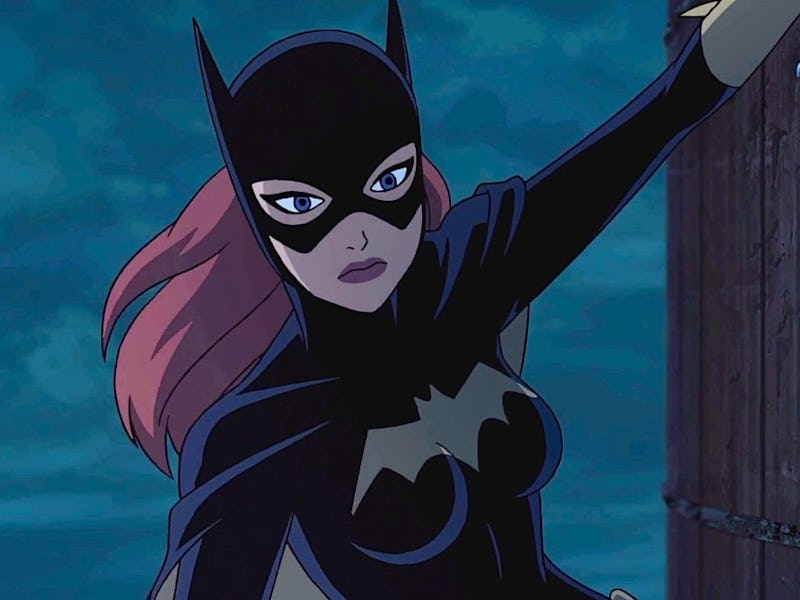'Killing Joke' Twists Batgirl's Legacy in Batman Sex Scene
Fans are confused and torn apart by the controversy, thanks to a Comic Con leak.

On Friday, leaked footage from The Killing Joke surfaced on Twitter, depicting a sex scene between Bruce Wayne’s Batman and Barbara Gordon’s Batgirl. Reviews of the film confirmed the scene’s existence. Later, another scene appeared on YouTube, revealing a conversation between Barbara and Bruce in which Barbara says, “it was just sex for God’s sake! It doesn’t have to mean anything, it’s not like we have to care! I don’t care, you don’t care. We just go back like it was, that’s all!” The conversation feels aptly adolescent for a character like Barbara, but mind-meltingly strange for someone like Bruce Wayne.
Fans, understandably, were confused. Even creators weighed in on the new connection, and Gail Simone went so far as to suggest The Killing Joke wasn’t as influential as most analysts still maintain it was.
The decision for the two superheroes have casual sex, made by Bruce Timm, Alan Burnett, and screenwriter Brian Azzarello, changes several aspects of both the character’s histories, and twists the film’s overall interpretation of Alan Moore’s infamous comic. Although a sexual or romantic relationship between the two had been teased in some ancillary Batman canon projects (specifically in Batman Beyond), their union is not a mainstay in Gotham stories. Still, director Bruce Timm defended the decision to put in a Wayne-Gordon sex scene.
“It was really important to us to show that both of the characters make some pretty big mistakes. I mean, his ‘parental skills’ aren’t that great,” Timm told Vulture. “Maybe never having had any kids of his own, he doesn’t realize that if you tell a kid to not do something, they’re going to want to do it even more. And then she makes some mistakes and then he kind of overreacts to her mistakes and then she overreacts to his overreaction. So it’s very human; it’s a very understandable story.”
Behold, a grainy screenshot of a grainy illegal gif made from a leaked video.
In the Killing Joke comic, the focus is on three events of monumental importance: The Joker paralyzes Barbara Gordon and tortures Commissioner Gordon, and Batman decides not to kill The Joker in response. The book ends on an intriguing note, signifying tonally that Batman and The Joker have more in common than Batman is often willing to admit. When the filmmakers announced that the elongated Killing Joke film would include “Batgirl’s backstory,” fans certainly didn’t assume that the added scenes would include, well, Barbara being groomed by her teacher.
Making Batgirl and Batman sexual partners earlier in the story – before Barbara is raped and shot through the spine by The Joker – further belabors the problematic nature of Barbara’s role. Alan Moore made Barbara Gordon, Bruce Wayne’s protege and young student, into a victim in his comic. The Killing Joke film has made Barbara’s sexuality into something Bruce Wayne has to defend against The Joker.
Instead of combating a rapist and a criminal, he’s now combating a rapist, a criminal, and in a nauseating sense, a rival for Barbara’s body. There’s something skin-crawling afoot about consent here, too, because in the Killing Joke scene leaked via Twitter, Bruce seems unwilling to talk about sex with Barbara after they’ve already had it, though it’s unclear why he’s evading her questions.
No matter how fans feel about the new plot development, it certainly feels ill-timed for the DCU. DC has made strides toward giving its on-screen female heroes more agency, but having Barbara Gordon fuck her mentor feels like a step backward. Wonder Woman’s stellar film poster just dropped, for instance, and DC fans are still reeling from the news that Margot Robbie may star in a Harley Quinn solo movie, featuring both Batgirl and the Birds of Prey. Why, one might ask, would DC undercut her independence before she even makes her live-action debut?
In addition to introducing sex between Barbara and Bruce, The Killing Joke confirms that The Joker prefers prostitutes, and in one scene, a sex worker notes that the Joker didn’t visit her after breaking out of Arkham. That new dialogue, paired with the popular reading of The Killing Joke, which assumes Joker rapes Barbara in order to enrage Batman and torture her father, adds several steps to Joker’s now implicit, sexualized rampage post-prison-break.
Bruce Timm, oddly, told Vulture that he believes the original Killing Joke comic used Barbara’s body and sexual agency as a plot point for Bruce’s emotional arc, but he apparently believes his film remedies that. “Even back when I first read it, I was very aware that Barbara was basically there just to be maimed and set Batman off on his quest to find the Joker and save Commissioner Gordon. This was years before the term women in refrigerators was coined, but it’s the classic woman-in-the-refrigerator situation, where the female in the story is basically only used as a plot device for the male protagonist.”
Certain cynics will call Barbara and Batman’s coitus a desperate grab for PR, in the same way many derided the decision to make The Killing Joke an R-rated film. Though many have discussed whether these developments have merit or influence as cultural products, it’s more fitting to analyze The Killing Joke as a marketing tool for DC and its future films. It appears that the publisher has moved forward with projects reaching for shock value, despite Geoff Johns’s assertions that DC’s superheroes needed to retain their original, admirable sheen, based in legacy and healthy, resonant connections between them.
It’s obvious there’s a disconnection happening at DC, a company that just released a stunning trailer for Wonder Woman but is evidently still grappling with the misogyny in its long history. Here’s hoping The Killing Joke isn’t an indication of where the company plans to go with its properties.